Omron Automatic Blood Pressure Monitor JPN500 User Guide
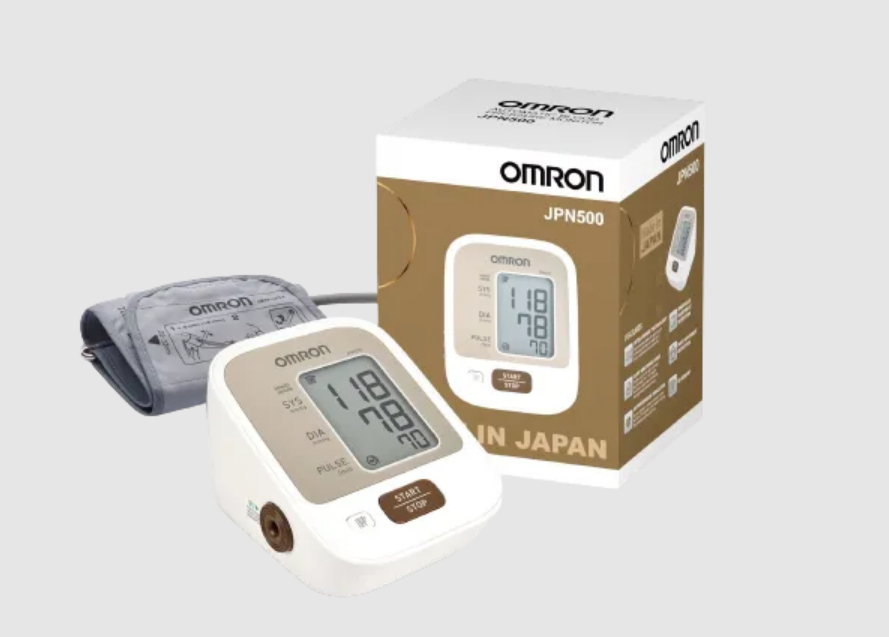
Content
Introduction
The Omron Automatic Blood Pressure Monitor JPN500 is a compact, fully automatic device designed for easy and accurate blood pressure monitoring at home. Utilizing advanced IntelliSense technology, it ensures comfortable inflation and precise readings without the need for manual adjustments. The monitor features a large LCD display for easy reading and can store up to 60 measurements, making it ideal for tracking health over time. Priced at approximately $128.00, it offers a reliable solution for health-conscious individuals.
The OMRON JPN500 is a compact, fully automatic blood pressure monitor, operating on the oscillometric principle. It measures your blood pressure and pulse rate simply and quickly. For comfortable controlled inflation without the need of pressure pre-setting or re-inflation the device uses its advanced “IntelliSense” technology.
Intended Use
This product is designed to measure the blood pressure and pulse rate of people within the range of the designated arm cuff, following the instructions in this instruction manual.
- It is mainly designed for general household use. Please read the Important Safety Information in this instruction manual before using the unit.
- Please follow this instruction manual thoroughly.
- Please keep for future reference.
- For specific information about your own blood pressure, CONSULT YOUR DOCTOR.
Technical Data
| Product Description | Automatic Blood Pressure Monitor |
|---|---|
| Model | JPN500 |
| Display | LCD Digital Display |
| Measurement Method | Oscillometric method |
| Measurement Range | Pressure: 0 to 299 mmHg <br> Pulse: 40 to 180 beats/min. |
| Accuracy | Pressure: ±3 mmHg <br> Pulse: ±5% of display reading |
| Inflation | Fuzzy-logic controlled by electric pump |
| Deflation | Automatic pressure release valve |
| Memory | 60 measurements 1 |
| IP classification | IP 20 |
| Rating | DC6V 4W |
| Power Source | 4 "AA" batteries 1.5V <br> or AC adapter (optional, INPUT AC100-240V 50/60Hz 0.12A) |
| Battery Life | Approx. 1000 measurements (using new alkaline batteries) 2 |
| Durable Period | Main Unit: 5 years <br> Cuff: 1 year (when used 6 times a day) |
| Applied Part | Type BF |
| Protection Against Electric Shock | Internally powered ME equipment (When using only the batteries) <br> Class II ME equipment (Optional AC adapter) |
| Operating temperature/ Humidity/ Air Pressure | +10 to +40°C / 30 to 85% RH / 700 to 1060 hPa |
| Storage temperature/ Humidity/ 3 Air pressure | -20 to +60°C / 10 to 95% RH / 700 to 1060 hPa 4 |
| Console Weight | Approx. 250g without batteries |
| Cuff Weight | Approx. 130g |
| Outer Dimensions | Approx. 103 (w) mm x 80 (h) mm x 129 (l) mm |
| Cuff Dimensions | Approx. 145 mm x 466 mm (Cuff: arm circumference 22 to 32 cm) |
| Cuff/ Tube Material | Nylon, polyester, polyvinyl chloride |
| Package Contents | Main unit, arm cuff, instruction manual, EMC information, battery set |
Notes:
- Subject to technical modification without prior notice.
- This device is clinically investigated according to the requirements of ISO 81060-2:2013.
- IP classification is degrees of protection provided by enclosures in accordance with IEC 60529. This device is protected against solid foreign objects of diameter 12 mm such as a finger and greater.
Overview
Main unit:
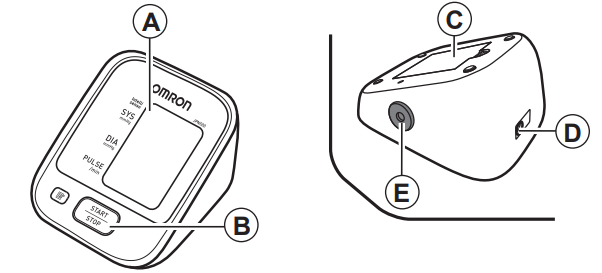
- A. Display
- B. START/STOP button
- C. Battery compartment
- D. AC adapter jack (for optional AC adapter)
- E. Air jack
Arm cuff:
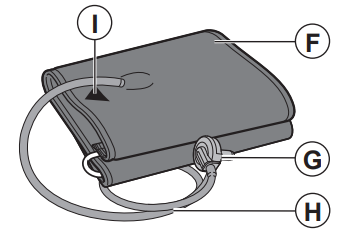
- F. Arm cuff (Arm circumference 22 - 32 cm)
- G. Air plug
- H. Air tube
- I. Marker
Display:
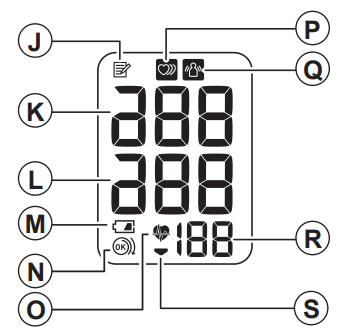
- J. Memory symbol
- K. Systolic blood pressure
- L. Diastolic blood pressure
- M. Low battery symbol
- N. Cuff wrapping guide
- O. Heartbeat symbol
- Flashes during measurement.
- If flashing after measurement completed or when viewing results stored in the memory, indicates blood pressure out of recommended range*.
- P. Irregular heartbeat symbol
- Q. Movement error symbol
- R. Pulse display
- S. Deflation symbol
Note: If your systolic or diastolic pressure is outside the standard range (above 134/84 mmHg) the Heartbeat symbol ( ) will blink. Please refer to Section 3.3.
Description
The Omron JPN500 features a sleek and compact design, making it easy to store and transport. The large LCD display ensures that readings are clear and easy to read, even for those with vision impairments. The monitor comes with a comfortable and adjustable cuff that fits a wide range of arm sizes, ensuring accurate readings regardless of your arm size.
The device also includes advanced health indicators such as an irregular heartbeat detector and a hypertension indicator. These features provide additional insights into your health, helping you and your healthcare provider make informed decisions.
Preparation
Installing/Replacing the Batteries
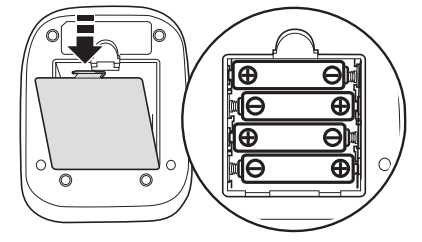
- Remove the battery cover.
- Insert four “AA” batteries as indicated in the battery compartment and then replace the battery cover.
Notes:- If the low battery symbol ( ) appears on the display, turn the monitor off then replace all batteries at the same time.
- The measurement values continue to be stored in memory even after the batteries are replaced.
- The supplied batteries may have a shorter life.
- Dispose of the device, components and optional accessories according to applicable local regulations. Unlawful disposal may cause environmental pollution.
Using the Unit
Applying the Arm Cuff
Remove tight-fitting clothing or tight rolled up sleeve from your upper arm. Do not place the arm cuff over thick clothes.
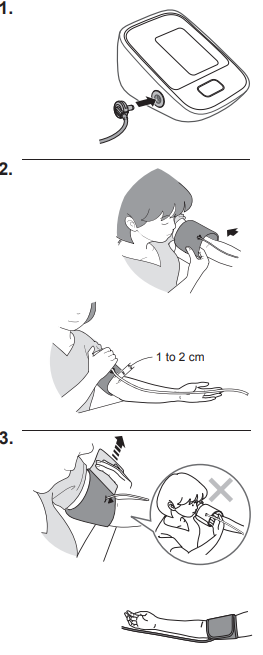
- Insert the air plug into the air jack securely.
- Put your arm through the cuff loop.
The bottom edge of the arm cuff should be 1 to 2 cm above the elbow. Marker (arrow under the air tube) is centred on the middle of your inner arm. - Close the fabric fastener FIRMLY.
Notes:
- When you take a measurement on the right arm, the air tube will be at the side of your elbow. Be careful not to rest your arm on the air tube.
- The blood pressure can differ between the right arm and the left arm, and therefore also the measured blood pressure values can be different. OMRON recommends to always use the same arm for measurement. If the values between both arms differ substantially, please check with your doctor which arm to use for your measurement.
How to Sit Correctly
To take a measurement, you need to be relaxed and comfortably seated, under comfortable room temperature. Avoid bathing, drinking alcohol or caffeine, smoking, exercising or eating 30 minutes before taking a measurement. Also avoid taking measurements during stressful time. Stress raises blood pressure.

- Sit on a chair with your legs uncrossed and your feet flat on the floor.
- Sit upright with your back straight.
- Sit with your back and arm being supported.
- The arm cuff should be placed on your arm at the same level as your heart.
Taking a Reading
Notes:
- To cancel a measurement, press the START/STOP button to release the air in the arm cuff.
- Remain still while taking a measurement.
Press the START/STOP button.
The arm cuff will start to inflate automatically.
If your systolic pressure is more than 210 mmHg
After the arm cuff starts to inflate, press and hold the START/STOP button until the monitor inflates 30 to 40 mmHg higher than your expected systolic pressure.
Notes: The monitor will not inflate above 299 mmHg. Do not apply more pressure than necessary.
Note: Wait 2-3 minutes before taking another blood pressure measurement. Waiting between readings allows the arteries to return to the condition prior to taking the blood pressure measurement.
Always consult your doctor. Self-diagnosis of measurement results and self-treatment are dangerous.
Cuff Wrapping Guide:
The Cuff Wrapping Guide is a unique feature that indicates if the cuff is not wrapped tightly enough around the arm. Even when the appears on the display, a blood pressure reading will be taken.
Note: This reading is NOT reliable due to the incorrect wrapping of the cuff. Please wrap the cuff again, taking care to wrap it correctly and take the measurement again. When the is displayed, the cuff is correctly wrapped tightly enough on the arm and the reading is accurate and reliable.- Remove the arm cuff.
Press the START/STOP button to turn the monitor off.
The monitor automatically stores the measurement in its memory. It will automatically turn off after 2 minutes.
Important: If your systolic or diastolic pressure is outside the standard range, the heartbeat symbol will blink when the measurement result is displayed. Recent research suggests that the following values can be used as a guide to high blood pressure for measurements taken at home.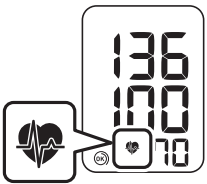
Systolic Blood Pressure ≥ 135 mmHg
Diastolic Blood Pressure ≥ 85 mmHg
This criteria is for home blood pressure measurement.
Your blood pressure monitor includes an irregular heartbeat feature. Irregular heartbeats can influence the results of the measurement. The irregular heartbeat algorithm automatically determines if the measurement is usable or needs to be repeated. If the measurement results are affected by irregular heartbeats but the result is valid, the result is shown together with the irregular heartbeat symbol (
 ). If the irregular heartbeats cause the measurement to be invalid, no result is shown. If the irregular heartbeat symbol (
). If the irregular heartbeats cause the measurement to be invalid, no result is shown. If the irregular heartbeat symbol ( ) is shown after you have taken a measurement, repeat the measurement. If the irregular heartbeat symbol (
) is shown after you have taken a measurement, repeat the measurement. If the irregular heartbeat symbol ( ) is shown frequently, please make your doctor aware of it.
) is shown frequently, please make your doctor aware of it.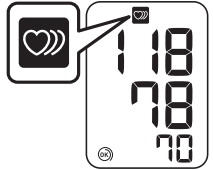
- If you move during measurement, the movement error symbol (
 ) will appear on the display. Keep still and repeat the measurement.
) will appear on the display. Keep still and repeat the measurement.
Using the Memory Function
The monitor automatically stores the result up to 60 sets.
Note: If the memory is full, the monitor will delete the oldest reading.
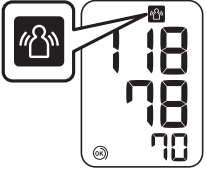
To View the Readings Stored in Memory
Press the
 button.
button.
The Memory number appears for a second before the pulse rate is displayed. The newest set is numbered “1”.
Notes:
- If your systolic or diastolic pressure is outside the standard range, the heartbeat symbol will blink when the measurement result is displayed.
- The cuff wrapping guide result appears on the display with the measurement values.
- If there are no measurements results stored in the memory, the screen to the right is displayed.
- Press the button repeatedly to view the readings stored in memory.
To Delete All the Values Stored in Memory
When the memory symbol (![]() ) appears, first press the Memory button. Then while holding it down, press the START/STOP button simultaneously for more than 3 seconds.
) appears, first press the Memory button. Then while holding it down, press the START/STOP button simultaneously for more than 3 seconds.
Note: You cannot partially delete the stored readings.

Setup Guide
To set up the Omron JPN500,
- Start by inserting the batteries into the device. Ensure that the cuff is properly adjusted to fit your arm comfortably.
- Wrap the cuff around your upper arm, making sure it is not too tight or too loose.
- Press the start button to begin the measurement process.
- The monitor will automatically inflate the cuff and take your blood pressure reading.
Once completed,
- The monitor will display your systolic, diastolic, and pulse readings on the LCD screen.
You can also configure multiple user profiles and store previous readings for future reference.
Maintenance
To protect your unit from damage, please observe the following:
- Do not subject the main unit and the cuff to extreme temperatures, humidity, moisture or direct sunlight.
- Do not fold the cuff or tubing tightly.
- Do not disassemble the unit.
- Do not subject the unit to strong shocks or vibrations (for example, dropping the unit on the floor).
- Do not use volatile liquids to clean the main unit.
- Do not wash the arm cuff or immerse it in water.
- Do not use petrol, thinners or similar solvents to clean the arm cuff.
- Do not carry out repairs of any kind yourself. If a defect occurs, consult your local OMRON representative.
- The unit should be cleaned with a soft, dry cloth.
- Use a soft, moistened cloth and neutral soap to clean the arm cuff.
Note: Read and follow the “Correct Disposal of This Product” in the Technical Data Section when disposing of the device and any used accessories or optional parts.

Calibration and Service
- The accuracy of this blood pressure monitor has been carefully tested and is designed for a long service life.
- It is generally recommended to have the unit inspected every two years to ensure correct functioning and accuracy. Please consult your local OMRON representative.
Storage
Store the device and the components in a clean, safe location.
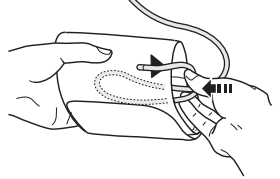
- Unplug the air plug from the air jack.
- Gently fold the air tube into the arm cuff.
Notes:- Do not bend the air tube excessively.
- Do not store the unit in the following situations:
- If the unit is wet.
- Locations exposed to extreme temperatures, humidity, direct sunlight, dust or corrosive vapors such as bleach.
- Locations exposed to vibrations, shocks or where it will be at an angle.
Optional Parts

- Small Cuff
HEM-CS24- Arm circumference
17 - 22 cm
- Arm circumference
- Medium Cuff
HEM-CR24- Arm circumference
22 - 32 cm
- Arm circumference
- Wide Range Soft Cuff
HEM-RML31- Arm circumference
22 - 42 cm
- Arm circumference
AC Adapter S
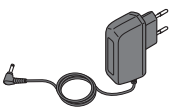
Notes:
- Please use Adapter [60110HW5SW] in Taiwan and adapter [6V06ASW-KA] in Korea.
- Please check with your local OMRON representatives for the appropriate optional parts.
Using the Optional AC Adapter
- Insert the AC adapter plug into the AC adapter jack on the rear side of the main unit.
- Plug the AC adapter into an electrical outlet.
To disconnect the AC adapter, unplug the AC adapter from the electrical outlet first and then remove the AC adapter plug from the main unit.
Error Messages
Error Display | Cause | Remedy |
Irregular heartbeats are detected. | Remove the arm cuff. Wait 2 - 3 minutes and then takeanother measurement. Repeat the stepsin section 3.3. If this errorcontinues to appear, contact your doctor. | |
Movement duringmeasurement. | Carefully read and repeat thesteps in section3.3. | |
|
Cuff is not appliedcorrectly. | Apply the arm cuff correctly. Refer to section 3.1. |
Thebatteries are low. | You shouldreplace them with new ones ahead of time. Refer to section2.1. | |
E1 | The batteries are exhausted. | You shouldreplace them with new ones at once. Refer to section 2.1. |
| E2 |
Air plug disconnected. | Insert the plug securely. Refer to section 3.1. |
Arm cuff not appliedcorrectly. | Apply the arm cuff correctly. Refer to section 3.1. | |
Air is leaking from the arm cuff. | Replace thecuff with the new one. Refer to Chapter 5. | |
| E3 |
Movement duringmeasurement and the arm cuff has not been inflated sufficiently. | Repeat measurement. Remain still anddo not talkduring measurement. Refer to section3.3. |
If “E2”appears repeatedly, inflate the cuff manually until it is 30 to 40 mmHg above your previous measurement result. Refer to section3.3. | ||
| E4 | Thearm cuff was inflated above 299 mmHg when inflating the cuff manually. | Donot inflate the cuff above 299mmHg. Refer to section 3.3. |
| E5 |
Movement duringmeasurement. | Repeat measurement. Remain still anddo not talkduring measurement. Refer to section3.3. |
| E6 |
Clothing is interfering with the arm cuff. | Remove any clothing interfering with the arm cuff. Refer to section 3.1. |
| Er | Device error. | Contact your localOMRON representative. |
Troubleshooting
Problem | Cause | Remedy |
The reading is extremely low (or high). |
Arm cuff not appliedcorrectly. | Apply thearm cuff correctly. Refer to section 3.1. |
Movement or talking during measurement. | Remain stilland do not talk duringmeasurement. Refer to section3.3. | |
Clothing is interfering with the arm cuff. | Remove any clothing interfering withthe arm cuff. Refer to section3.1. | |
Arm cuffpressure does not rise. | The air tube is not securely connected into the main unit. | Make surethat the air tube is connected securely. Refer to section3.1. |
Air is leaking from the arm cuff. | Replace the arm cuff with a new one. Refer to Chapter 5. | |
Arm cuff deflates too soon. |
The arm cuff is loose. | Apply the cuff correctly so that it is firmly wrapped aroundthe arm. Refer to section 3.1. |
Cannot measure or readings are too low or too high. |
The arm cuff has not been inflated sufficiently. | Inflate the cuff so that it is 30 to 40 mmHg aboveyour previous measurement result. Refer to section3.3. |
Nothing happenswhen you pressthe buttons. | The batteries are empty. | Replace thebatteries with new ones. Refer to section 2.1. |
The batteries have been inserted incorrectly. | Insert the batteries with the correct(+/-) polarity. Refer to section 2.1. | |
Other problems. |
measurement.
batteries with new ones. If thisstill does notsolve the problem, contact your local OMRON representative. | |
Pros & Cons
Pros
- Accurate and reliable readings
- User-friendly design with automatic inflation
- Multiple user memory storage
- Irrregular heartbeat detector and hypertension indicator
- Portable with travel case included
Cons
- Battery life may vary depending on usage
- Some users find the cuff too large or too small
- No Bluetooth or Wi-Fi connectivity for data transfer
Customer Reviews
Customers have generally praised the Omron JPN500 for its accuracy and ease of use. Many appreciate the additional health indicators and the ability to store multiple user profiles. However, some users have reported issues with the cuff size and battery life.
Common complaints
- The cuff size does not fit all arm sizes comfortably.
- Batteries drain quickly if used frequently.
Faqs
How do I ensure accurate readings with the Omron JPN500?
Can I use the Omron JPN500 if I have an irregular heartbeat?
How many users can store their readings on the Omron JPN500?
What is the recommended cuff size for the Omron JPN500?
Does the Omron JPN500 come with any travel accessories?
How do I troubleshoot error messages on my Omron JPN500?
Is the Omron JPN500 suitable for people with large arms?
Can I use my Omron JPN500 while pregnant?
How often should I replace the batteries in my Omron JPN500?
Does the Omron JPN500 have Bluetooth or Wi-Fi connectivity?
Leave a Comment



